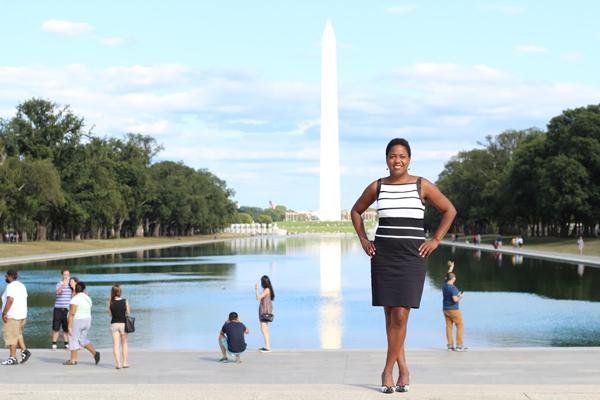Updated: Oct. 17, 2016 at 11:42 a.m.
Students in American Studies professor Calvin Warren’s “The African American Experience” course begin the semester reading Marcus Rediker’s “The Slave Ship: A Human History,” which details the history of slave vessels and how those ships diminish Africans from people to property.
Now, students in the class can experience stories from the book firsthand by visiting the Smithsonian’s National Museum of African American History and Culture to explore an entire floor related to the slave trade. The haunting relics include cast iron ballast bars from the São José Paquete de África, a Portuguese slave ship that crashed near Cape Town, leading to more than 200 slaves drowning.
The museum highlights African American contributions to art, fashion, music, dance, entrepreneurship, journalism, faith, education, activism and much more, and students and professors of multiple disciplines say they will be able to use the museum’s materials for their studies and pedagogy.
The National Museum of African American History and Culture opened last month after 13 years of planning, and tickets are already sold out until 2017. If you weren’t lucky enough to snag a ticket, you can line up before the museum opens at 10 a.m. to get in on a standby basis.
The museum tells the story of the African American experience in the U.S. chronologically and thematically. Visitors begin on the lowest concourse level at an exhibit on the trans-Atlantic slave trade and they then ascend through three levels of historical archives, ending with a display about U.S. President Barack Obama’s inauguration. The historical galleries end with a reflection room.
Jennifer James, the director of the Africana Studies program, said that the museum validates and strengthens an existing interest in African American history and culture.
“The museum represents a long overdue recognition of the centrality of African Americans to our collective national story,” she said.
James added that the Black Lives Matter movement has increased student interests in black contributions to American ingenuity.
“I think that the Black Lives Matter movement has contributed to students’ desire to connect our troubled present to past struggles and to draw strength from our remarkable resilience,” she said.
Students should learn about the legislative struggles that U.S. government officials went through to establish the museum, because that history plays a significant role in the museum’s educational potential, James said.
Early efforts for a museum documenting African American history and culture were introduced to Congress by Rep. John Lewis, D-Ga., in 1988 but were filibustered by Senate Republicans. Lewis continued to introduce legislation for the museum in every session of Congress until U.S. President George W. Bush signed the bill into law in 2003.
“Although this is a federally established institution, it took decades of hard work on the part of black activists to make this vision a reality,” James said. “To many, it seems as though the museum magically appeared overnight. That’s not the case.”
Kristen McInerney, a student at the Graduate School of Education and Human Development and a former assistant principal of a secondary school, said that the museum’s curriculum applications are “endless.”
“There are common threads, chronological timeline applications, legal and political applications, social justice and community unification themes that run throughout,” McInerney said.
Now that the museum is established and open, faculty at GW and other school teachers in D.C. can scope out ways to supplement existing class units with experiences at the museum, McInerey said.
Each of the museum’s approximately 3,500 artifacts on display highlight a different theme of African American history and culture. For example, Mary Ann Shadd’s “Letters from the Editress” (ca. 1855) exemplify the rise and importance of black journalism. And Gabby Douglas’s 2012 Olympic gymnastics uniform fits with a sports exhibit meant to document African Americans’ struggles to become respected in U.S. sports.
McInerey added that the museum will continue to add artifacts and exhibits as time goes on, which will open more opportunities for educational experiences.
“The museum’s artifacts end in 2008 with President Obama’s inauguration,” she said. “I am excited for them to keep adding.”
Rachel Décoste, the vice president of the Black Graduate Students Association, said that in the future, she hopes to see more exhibits specific to central events in African American history, like the Dred Scott case, the cotton industry, the intersection of African Americans and American Indians and the Underground Railroad.
The museum is especially interesting to students who descended from enslaved Africans, Décoste added.
“I have a keen interest in the story that is equal parts frightening, fascinating and, ultimately, empowering,” she said. “It is a journey that also gives insight into today’s socioeconomic matters, regardless of race.”
But students who are not slaves’ descendants have a lot to learn from the museum, too, Décoste said.
“They are the ones who need to be educated, enlightened and sensitized to these stories,” she said.
This post was updated to reflect the following correction:
The Hatchet incorrectly reported that Rachel Décoste is the finance chair of the Black Graduate Students Association. She is the organization’s vice president. We regret this error.







